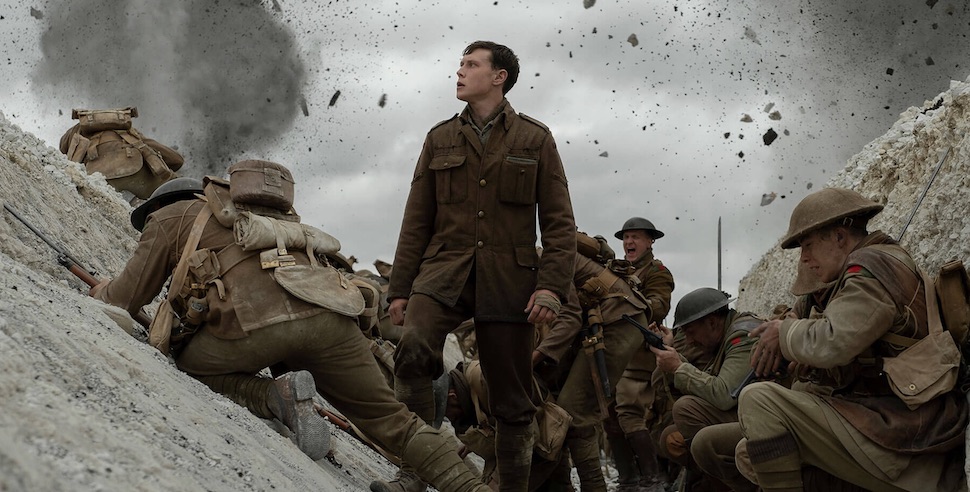About half an hour into 1917 — Sam Mendes’ World War I odyssey that is filmed in a way to create an illusion of being one continuous shot — there’s a scene in which I literally reached for the screen and made a sound that kind of resembled, “Oh no!,” and did my best to try and stop what was about to happen. (I won’t go into too much detail about what the scene is, but it involves a very large rat dragging a bag of food towards a tripwire set as a booby trap by the Germans.) Now, I am not normally someone who does this sort of thing during a movie. In fact, I often get annoyed when people around me get a little too animated while watching movies. And when it does happen to me, I feel embarrassed, as if I’m annoying the people around me. Anyway, yes, this happened to me five or six times while watching 1917.
1917‘s existence at all is kind of a strange one. It doesn’t star famous people (even though there are a few well-known names we run into as the movie progresses, but these are all basically cameos) and it’s centered around a war that not many people talk about today. (I suspect people are probably more familiar with the Scottish rock band Franz Ferdinand than the archduke whose assassination was the catalyst for starting World War I.) The two great wars are only, roughly, 20-some years apart, but there’s still something about World War II that feels more modern. There are still people alive today to tell us about it (though, unfortunately, those numbers are dwindling rapidly). But, for me, this was something appealing about 1917. I know it was a brutal war (in as much as some wars can be more brutal than others, even though that word is always going to apply, but perhaps that’s why it’s not as easily cinematic? The trench warfare aspect of the first World War is brutally repetitive. (There’s even a line in 1917 where a character laments that the victor will just be the last man standing.)
Look, I was skeptical of the whole “one continuous shot” thing. I was worried it might try to get a little too cute like Birdman, even though I still like Birdman. Yes, Birdman is pretentious, but I kind of appreciate that it wears its pretentiousness on its sleeve and owns it. But pretentiousness isn’t a virtue I want to see in a movie about World War I. But what Mendes does with this storytelling trick is to create a movie where we, the audience, feels like we are in World War I for two hours. And it’s effective. It’s basically buying a ticket to experience hell for two hours.
When the film opens, British soldiers Blake (Dean-Charles Chapman) and Schofield (George MacKay) are given orders to deliver a very important message to a different regiment. The Germans are setting a trap. If an attack goes off as planned, thousands of British soldiers will be slaughtered (including Blake’s older brother). So that’s the movie, as we travel with Blake and Schofield through “no man’s land,” and into enemy territory for what amounts to (with some digital trickery) one continuous shot. It’s really quite something. (And to top all of this off, Academy Award winner Roger Deakins shot the film, so it goes without saying that it’s gorgeous. Also, the sets are remarkable. Imagine characters walking and talking like in an Aaron Sorkin project, only it’s miles and miles of trenches.)
There’s a scene I can’t stop thinking about as Schofield approaches another soldier. It’s nighttime, and the only light is from the city being on fire, which casts the approaching soldier as a silhouette. He seems friendly, then without warning he aims his rifle and starts charging. It’s literally something out of a nightmare as all Schofield can do is run. 1917 often plays as a pure horror movie, as the sounds of the bullets ricochet and scream through the speakers. (Yes, the bullets act as jump scares, which I’m usually not a fan of, but I’m going to guess the sound of a bullet hitting something near you in real life causes quite a jump scare.)
I’m hesitant to write this next part, as I’m afraid it will come off as a negative, but I don’t mean it that way. But the nature of the one continuous shot, and the fact we are with only two characters (and sometimes one; as opposed to Birdman, which is a true ensemble) creates this situation where these characters almost become avatars. Like we are on this mission, just like in a video game. (And when I say “video game,” I mean something like The Last of Us, not Q*Bert) But these two almost become our character as we try to complete this mission.)
Of course, this style leads to, maybe, a lack of emotional connection at times. (Though there is a banger of a scene that’s nothing but emotion.) We basically just get our orders and go. But I get the sense this is Mendes’ point. His goal is to put us in World War I for two hours. And, no, it’s not a pleasant experience. But what the movie is trying to do absolutely works. 1917 wants to take us to hell and back, and, in that, it succeeds.
You can contact Mike Ryan directly on Twitter.







